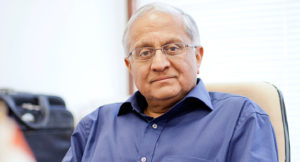Ashok Soota-led Happiest Minds Technologies has woven happiness into its business process. Find out how you can do it too.

Here is a little song I wrote, you might want to sing it note for note, don’t worry, be happy. In every life we have some trouble, when you worry you make it double, don’t worry be happy! Don’t worry, be happy now…
So go the lyrics to Bobby McFerrin’s Grammy award winning song which was very popular during my school days. I happened to listen to this tune after ages and it still brought a big smile to my face. There was one difference though; this time, I understood the meaning of the lyrics a lot better. Time has a way of showing one the importance of happiness. While happiness is a personal emotion, one that is subjective and connected to a circumstance, its meaning, essentially, remains the same for everybody.
To me, happiness encompasses so many other emotions like feeling grateful, intensely joyous, experiencing physical and emotional well-being, comfort, a sense of achievement, practicing ethics, being virtuous, being heard and much more. And happiness isn’t just a personal expression of emotion. It extends to one’s workplace and this is a fact that global corporations are beginning to take seriously. Clearly, a negative environment at the workplace breeds unhappiness, a feeling that one tends to carry home. This negativity can hamper productivity and there are many studies that empirically prove this; happy employees are more efficient employees. They are sensitive to opportunities and are generally more helpful towards coworkers. In fact, there is also a direct correlation between employee satisfaction and profitability.
Researchers, Dr Laurel Edmunds and Jessica Pryce-Jones, have defined workplace happiness as: “Happiness at work is about mindfully making the best use of the resources you have, to overcome the challenges you face. Actively relishing the highs and managing the lows will help you maximise your performance and achieve your potential. And this not only builds your happiness but also that of others – who will be affected and energised by what you do.”
In Shawn Achor’s The Happiness Advantage: The Seven Principles of Positive Psychology That Fuel Success and Performance at Work, the author suggests that happiness fuels success, not the other way around. When we are positive, our brains become more engaged, creative, motivated, energetic, resilient, and productive at work. Tony Hsieh, CEO of Zappos, an online apparel and shoe store, illustrates in his book, Delivering Happiness: A Path to Profits, Passion and Purpose, the significant benefits of inculcating a happy work culture. He asserts that by concentrating on the happiness of those around you, you can dramatically increase your own and this is a powerful, successful way to do business.
Closer home, Bengaluru-based Happiest Minds Technologies (Happiest Minds) is the first company in India that has set out a clear framework to implement happiness at its workplace. Its founder, Ashok Soota, has ensured that this mandate of making his people happy is woven into the business processes of the company and does not remain just a concept. In fact, right from the time he decided to set up this IT services company, he was very clear about the happiness philosophy that it would follow and even named the company after it.
To understand how other companies can embrace this philosophy, we spoke to Ashok Soota and his core team. We bring to you the learnings from Happiest Minds’ systems, policies and practices that are crafted to foster an open culture, enable people to discover their potential and help shape their own work and life experience.

1 IT ALL STARTS WITH A BELIEF
To formalise such an intangible emotion into an organisational structure takes immense belief on the part of its founders. Soota believes in not just workplace happiness, but happiness on the whole. As Raja Shanmugam, chief people officer of Happiest Minds, rightly states, “It is not an ISO 9000 certification where there is a clear methodology. It is about the intent and commitment to be happy, which is the starting point of creating a company with happiness as its structure.”
While Soota wants people to understand that it is their choice to be happy, he also wants to help them realise how important it is that they exercise their choice in favour of happiness. With this in mind, Soota set up the company with a mission statement; Happiest People and Happiest Customers. At Happiest Minds , happiness is built into everything it does. Its five-year vision (by FY 2017) is to be happiness evangelists for each other, its customers and society; create a launching pad for an IPO in six to seven years of operation; be known as the company with highest standards of governance; be a thought leader in its focused areas of technology and solutions and be a leader in integrating social responsibility initiatives with core business operations. The company’s acronym SMILES describes its core values: Sharing, Mindful, Integrity, Learning, Excellence and Social responsibility.
WHAT CAN YOU DO?
- The leadership and executive team should have immense belief in happiness and be willing to make a commitment to it.
- Build happiness into everything you do for your company. For that, your mission, vision and value statement must reflect your belief in happiness.
2 HIRE YOUR OWN HAPPINESS PERSON
Happiest Minds recruited its happiness evangelist, Sharon Andrew, a PhD in Servant-Leadership, who is responsible for evangelising happiness. However, the organisation realises that spreading happiness is not one person’s role. “We all have to be happiness evangelists for each other,” stresses Soota. To achieve this, Happiest Minds has established a certain culture and mindset and most importantly, the importance of gratitude within the organisation. “So many people remember the negatives in their lives and therefore make themselves unhappy without realising how much there is to be grateful for,” states Soota.
WHAT CAN YOU DO?
Recruit a lead person who will be responsible for implementing happiness in the business processes.
Remember that it is not just one person’s role to spread happiness.
3 WHEN PEOPLE ARE INVOLVED, THEY’RE HAPPY
Sharon sought feedback from Happiest Minds’ employees (close to 150 people) during the early days on what makes them happy. She and her team collated this information and in association with smaller teams across various business verticals grouped the happiness parameters into various buckets. Once this was done, they approached the leadership team, who advised them on the necessary changes to be made. This led to Happiest Minds’ 7Cs framework for Happiest People. “We were lucky that we found seven words that started with the letter C which are also easy to recall for all those involved,” says she.
WHAT CAN YOU DO?
Involve your people and co-create policies.
Have an advisor dedicated to finding your organisation’s way to happiness.
4 CREATING A GUIDE TO HAPPINESS
The seven components of Happiest Minds’ framework are not mutually exclusive but they are intertwined. The framework revolves around culture. The management believes that culture, especially its happiness culture, binds the organisation and its people together. The organisation believes in celebration, inclusion, being socially engaged and having an enriched personal life. Community and credibility are the other components of the framework. Its communication is transparent, open and spans 360 degrees. The company’s policies are co-created and supported mutually, and hence, collaboration is another part of its framework. “We make smaller teams from businesses who give us feedback and we work on it. The final policy is designed by us but the co-creation leads to it,” states Sharon. Contribution and choice are the other two Cs in the framework.
A company that has been in existence for a long time can also rework its policies to make it a happiness-driven workplace. But, the size of commitment has to be that much more. It must have a clear need to follow through as it is changing its own culture. “What is wrong with what we have right now, why do we need to change and what does it take to change?” – these are some questions it needs to answer. You need to have that commitment to believe that people are at the centre of who we are and that being happy is a part of life’s philosophy, regardless of what else is happening and build it into the fabric of the company. – Raja Shanmugam
Remember that the framework is a living document and there is always a chance that one may not have covered everything that needs to be in there. “This is not the 10 commandments which God wrote on stone. I would like people to tell us if we have missed out something significant,” comments Shanmugam.
WHAT CAN YOU DO?
- Create your own happiness framework.
- Keep it flexible.
5 SPREAD THE CHEER
One of the main exercises by Happiest Minds was to work with Great Places to Work Institute (a research, consulting and training firm that helps organisations identify, create and sustain great workplaces) and take its people practices with respect to the life cycle of an employee in an organisation. It has mapped Great Places to Work Institute’s 15 steps or people practices with its 7Cs framework. For example, what does it take to hire a person? How will he/she experience 7Cs? How will he/she feel if given a choice while being hired? The company builds these answers into its framework and calls it the Happiness Manifesto. “The intersection of our framework and the Great Places to Work Institute’s people practices will help us build new things,” says Shanmugam.
At Happiest Minds, one of the important aspects of its Happiness Manifesto is the focus on wellness. The company has several learning and development programmes that encompass social, environmental, emotional, intellectual, occupational and spiritual elements. The company has tied up with the Get Active program of 2mpower Health Management Services for its pedometers, a portable electronic device that counts each step taken by a person. It also arranges for training on ergonomics. The company has had keyboards and computer mouses changed for employees who have had repetitive stress injuries. In the near future, it plans to include Tai Chi classes as part of its wellness initiative. These are just a few examples of how Happiest Minds has communicated its ‘I care’ attitude to its employees and this has gone a long way in keeping them happy.
The company’s founders conduct regular mission – vision – value sessions that help instill its SMILES values. While this is mainly intended for new employees, those who have been in the system also attend these sessions.
Research suggests that each person has a different setpoint for happiness, which is based on genetics and environment. But it also states that it is very easy for us to increase the setpoint for happiness and that is what we look at. We have programmes designed to build the capacity of these setpoints. – Sharon Andrew
What makes life at Happiest Minds considerably easier is that it hires people who believe in happiness. “We need people who align with our mission, believe that our five-year vision is memorable and achievable and like our values and are committed to living by them,” states Sharon. Happiest Minds has designed SMILES advantage – a document that captures information on the interview – for hiring, which helps the interviewer assess the qualities of the interviewee. Integrity is one quality it does not compromise on while hiring. Soota believes that integrity is black or white; there are no grey areas in between. In fact, as a part of the interior décor, the company has a picture of a white swan on a black background, to signify integrity.
However, Sharon agrees that there are business pressures and the setpoints for hiring vary. But she is quick to add, “That is where the skill development programmes come in. This year, one of my objectives is to design and deliver a course on happiness evangelism. I am sure that will help people improve their setpoints.”
WHAT CAN YOU DO?
- Map the work processes with the framework.
- Instill values of the organisation among the employees.
- Hire people who believe in happiness.
- Conduct skill development and wellness programmes to enhance happiness.
6 TIPPING THE SCALE OF HAPPINESS
Happiest Minds has designed the Happiest People Pulse ©- a set of 50 statements – that is measured on a Likert scale of strongly agree to strongly disagree on an annual basis. Apart from learning that its employees are happy, a very important learning for Happiest Minds through this exercise was the need for learning and development (L&D) programmes. Though the company had training sessions for assimilation of mission-vision-values, it did not have a formal L&D program in place yet. “This was a pertinent feedback and therefore, now we have a full time L&D head working towards building a team dedicated to skill and capacity building for our workforce,” says Sharon.
We have created a 24/7 industry and often, both members of the family are working, resulting in a lot of pressures in their lives. There are wellness issues which are cropping up at a younger age and all of this impacts happiness. We want people to realise the importance of happiness. While it is their choice, we want them to understand the importance of exercising their choice in favour of happiness. – Ashok Soota
The company also has another metric called Touchstones which is a people happiness barometer to be filled in by the project manager on behalf of his / her team. It is a nine-statement, monthly exercise with yes, no and not sure check boxes and a comment box. It covers aspects like whether the team has clarity on goals and objectives, are roles and responsibilities well-defined, identifies if everyone is participating in workplaces happiness activities, are they learning new things in the project, are they happy, do they find support from the others and so on. The company translates this into a heat map, which once generated, is given to the people engagement team. “This essentially helps us look at the implementation of our happiness framework project-by-project,” says Sharon.
The company reaches out to its people in a simple way and responds to their concerns. For example, there was a feedback from a team about not knowing what is happening on the business front. And to address this, Happiest Minds has a monthly newsletter for each of the businesses that keep its employees abreast about new technologies, updates on business milestones and so on.
Happiest Minds has a 360 degree appraisal to bring in a level of objectivity, fairness and openness. “So my teammate can rate me on my KRAs,” states Shanmugam. He continues, “Two things happen here. One, he/she sees my self-appraisal and if I am inflating my achievements he/she can comment on it. So there is a certain mechanism built in to make sure we are honest across the board. Two, he/she now has the view that he / she is influencing his / her supervisor’s performance. That is a big feeling of contribution to the organisation in addition to the feeling of possessing an ability to control what is going on.”
WHAT CAN YOU DO?
- To measure the effectiveness of your framework:
- Have an exhaustive annual feedback exercise.
- Have regular (can be monthly or quarterly) feedback from project managers and his/her teams.
- Respond to the concerns of your employees.
- 360-degree appraisal.
7 IN IT FOR THE LONG HAUL
Usually, there are uncertainties as to whether a company can sustain this policy in the long-run especially as it scales up. During the initial days, Happiest Minds had a count of 100 employees. It now has 1,000 employees and is going strong with its policy of building a happiness-driven company. In fact, the success of its endeavour is reflected in its attrition rate. “Our attrition is currently about 7 per cent which is low when compared to the IT services sector’s 16 per cent,” says Shanmugam.
When customers talk to someone who says that they are happiest, it creates a positive vibe. However, the question is, how is it going to help better customer engagement? Clarifying, Shanmugam says, “The happiness quotient helps people get more engaged and they extend and commit themselves to the work better.” The company is also in the process of designing the happiest customer index and is hoping to roll this out by FY 14. “At some point we need to look at correlations between happiest people and happiest customers and tell the world that what we have been saying is measurable and practical as well,” asserts Shanmugam.
WHAT CAN YOU DO?
- Build a scaleable framework and sustain it.
- Be open about your policy so that others can learn from it.
One of the goals that Soota clearly laid down was that he and his team wanted to create a company which will go public, in about five years from now. There are two reasons for that. One, is that Happiest Minds wants to demonstrate to the world that it has the highest standard of corporate governance which is also a very important part of its vision. Second, the company wants its team to be able to monetise the wealth that it has created. “Until March 31, 2013, we have been granting stock to everybody at the same price at which the founders came on board. So we want the entire team to be a part of the wealth creation process,” says Soota. His aim is to see Happiest Minds as an organisation where people take enormous pride in saying, “Yes, we work at Happiest Minds and it is more than a job.” For him, achieving financial goals is a by-product. And for entrepreneurs who want to instill this culture in their organisation, it is all about believing and sustaining that belief. So, don’t worry, be happy. No really, build a happy company!
A means to happiness
An interview with Ashok Soota, founder and executive chairman, Happiest Minds Technologies
Before founding Happiest Minds in August 2011, you had a very successful innings at Wipro. You later co-founded Mindtree and led it through a very successful IPO. What were your key learnings during your professional journey, prior to setting up Happiest Minds?
I put those learnings into two groups – business learnings and people-related learnings. On the business front, I realised that this is a relationship business, experience business and expertise business and it is important that all these three are handled in a very holistic way. And the eventual essence for success is really going to be the experience that your customers have. So how do you build on those experiences as you go ahead?
On the people front, there is an enormous amount of learning. This is a knowledge business and you have to provide your people the opportunity to continuously learn. It is teamwork all the way, when one works on projects. The question is how do you build on your teams? It is clear that happiest people lead to happiest customers, so how do you maximise the happiness framework within the organisation? I am looking at happiness as the end goal.
To quote Aristotle – happiness is the meaning and the purpose of life, the whole aim and end of human existence. So I would like people to focus on it and through that process, maximise their own happiness.
Where do you see your company five years from now and how do you see the happiness framework evolving?
As per the time frame given to our investors, we have a clear goal to create a company which we will take public in approximately five years from now. The two main reasons for that are: One, we want the world to see the highest standard of corporate governance which is very dear to us and is also an important part of our vision. Second, we want to be able to help our teams monetise the wealth that we have created. We have been giving stock to everybody at the same price as that of the founders when they came on board. So we want the entire team to be a part of the wealth creation process.
I also want to see ourselves as an organisation where people take enormous pride in saying that they work for Happiest Minds and it is more than a job. Achieving our financial goals will be almost complementary as against the feeling of creating the right type of organisation that we set out to create.
There is some popular work done in the Silicon Valley to boost employee happiness – like the movement called deliveringhappiness.com. How has research work done in the global space helped you while setting up your organisation?
We are not just saying that we are creating a happy environment for our customers, but we also want to be seen as happiness evangelists for the society, at large. And therefore, I am amazed at the amount of interest there is on the theme and subject. There are some well-written books on this topic. If nothing else, all of us have understood what makes people unhappy and what you can do to maximise happiness. It is important to recognise the areas in which people have regret. And research shows that they didn’t focus enough on those things, which made them happy. Amongst other things, we continuously ask our people what makes them happy? At Happiest Minds, each one of us has three things documented about what makes us happy. We are expected to track it as our objective for the year and identify if we have done enough on focusing on those things. Five years later one should not look back and feel that they missed investing on things that was important to them.
What makes you happy?
Firstly, fulfilling my own potential in helping others in fulfilling theirs. Secondly, leading a life, which is true to myself and not necessarily based on the expectations of the others. For example, so many people asked me why I started a company at the age of 68. So, do what you think is going to give you satisfaction. And thirdly, knowing that I have a choice and that includes a choice for happiness.






